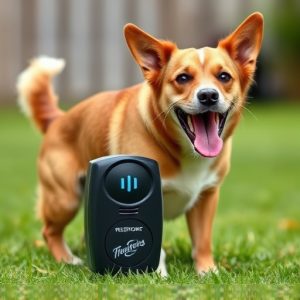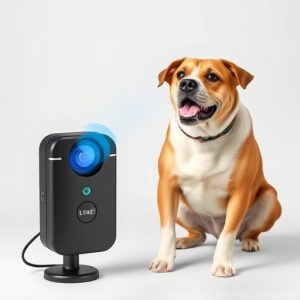Customizing Dog Barking Prevention: Effective Training Intensity Settings
Electronic bark control systems offer a humane solution for managing excessive dog barking by using…….
Electronic bark control systems offer a humane solution for managing excessive dog barking by using customizable Customize Bark Control Intensity Settings to trigger ultrasonic sounds or mild shocks. Training involves starting at the lowest intensity and adjusting based on your dog's sensitivity and behavior, ensuring effectiveness without causing discomfort. Proper implementation requires selecting the right device, acclimatizing your pet through positive reinforcement, and regular maintenance for sustained success.
“Unleash a quieter, more manageable canine companion with our comprehensive guide to dog barking prevention electronic systems. Understanding that excessive barking stems from various factors, we delve into the science behind these systems and how they can effectively curb unwanted behavior. From exploring the mechanics of bark control devices to offering tailored intensity setting tips for precise training, this article equips owners with knowledge for successful implementation and maintenance. Discover how to transform your dog’s barking into a harmonious part of your home.”
- Understanding Dog Barking Behavior and Its Causes
- How Electronic Bark Control Systems Work
- Customizing Bark Control Intensity Settings for Effective Training
- Implementation and Maintenance Tips for a Successful System
Understanding Dog Barking Behavior and Its Causes
Dog barking is a complex behavior that can stem from various triggers, making it essential to understand before implementing any control measures. Dogs bark for communication purposes, expressing emotions like excitement, fear, or frustration. It can also be a response to environmental stimuli such as loud noises, other animals, or even boredom and loneliness. Identifying the root cause of excessive barking is crucial in effectively addressing the issue.
One effective way to manage dog barking is by utilizing electronic bark control systems that allow for customization of intensity settings. These devices emit ultrasonic sounds or mild electric shocks when a dog barks excessively, reinforcing quiet behavior. By adjusting the sensitivity and response level according to the pet’s needs, owners can train their dogs to understand appropriate vocalization without resorting to excessive barking.
How Electronic Bark Control Systems Work
Electronic bark control systems are designed to address excessive dog barking through a series of gentle, yet effective stimuli. These systems typically use a combination of ultrasonic sounds, vibration, or even static electricity (in the form of a mild shock) to discourage barking. When a dog barks, the device detects the sound and activates the chosen method of correction. The key advantage lies in their ability to customize bark control intensity settings, allowing users to fine-tune the response according to their dog’s behavior and sensitivity. This personalization ensures that the system remains effective without causing any discomfort or stress to the animal.
By adjusting the sensitivity level, owners can set the system to respond only to specific types of barking, avoiding unnecessary triggers. The intensity settings range from gentle vibrations to higher-pitched sounds or mild shocks, allowing for a gradual approach to training. This flexibility is crucial in accommodating different dog breeds and temperaments, ensuring that the correction methods are suitable and effective without causing any harm.
Customizing Bark Control Intensity Settings for Effective Training
Training a dog to bark less involves finding the right balance in intensity settings for your electronic bark control system. These systems often come with adjustable levels, designed to respond to different barking situations. Start by setting the lowest possible intensity level and gradually increase it as needed. The goal is to find the point where the device effectively discourages excessive barking without causing discomfort or fear. Regularly monitor your dog’s response and adjust settings accordingly.
Customize Bark Control Intensity Settings based on factors like your dog’s sensitivity, training progress, and the type of barking they’re exhibiting. For example, a high-pitched bark may require a lower intensity setting than a deep, loud growl. By customizing these settings, you can ensure the system is effective yet humane, helping to train your dog towards more appropriate behavior without resorting to harsh methods.
Implementation and Maintenance Tips for a Successful System
Implementing an electronic dog barking prevention system requires a strategic approach for optimal success. The first step is to choose a device that suits your needs and fits seamlessly into your home environment. Look for features like customizable sensitivity levels, bark detection algorithms, and remote control capabilities to manage training effectively. Once installed, it’s crucial to acclimatize your pet to the device’s sound patterns through positive reinforcement training. Reward quiet behavior while occasionally triggering the device under controlled conditions to help your dog associate the sounds with their desired response.
Regular maintenance is equally vital for sustained effectiveness. Ensure the device’s sensors are clean and free from debris, and check battery life frequently, replacing them as needed. Keep an eye on your pet’s behavior, adjusting the bark control intensity settings as they learn and adapt to the system. Over time, gradually reduce the sensitivity as their barking improves, preventing any discomfort or fear while maintaining a peaceful environment for all residents.
In addressing dog barking issues, electronic bark control systems offer a humane and effective solution. By understanding canine behavior and customizing the intensity settings, pet owners can train their dogs successfully without resorting to harsh methods. Regular implementation and maintenance ensure these systems remain efficient, promoting peaceful coexistence between pets and their environments.


